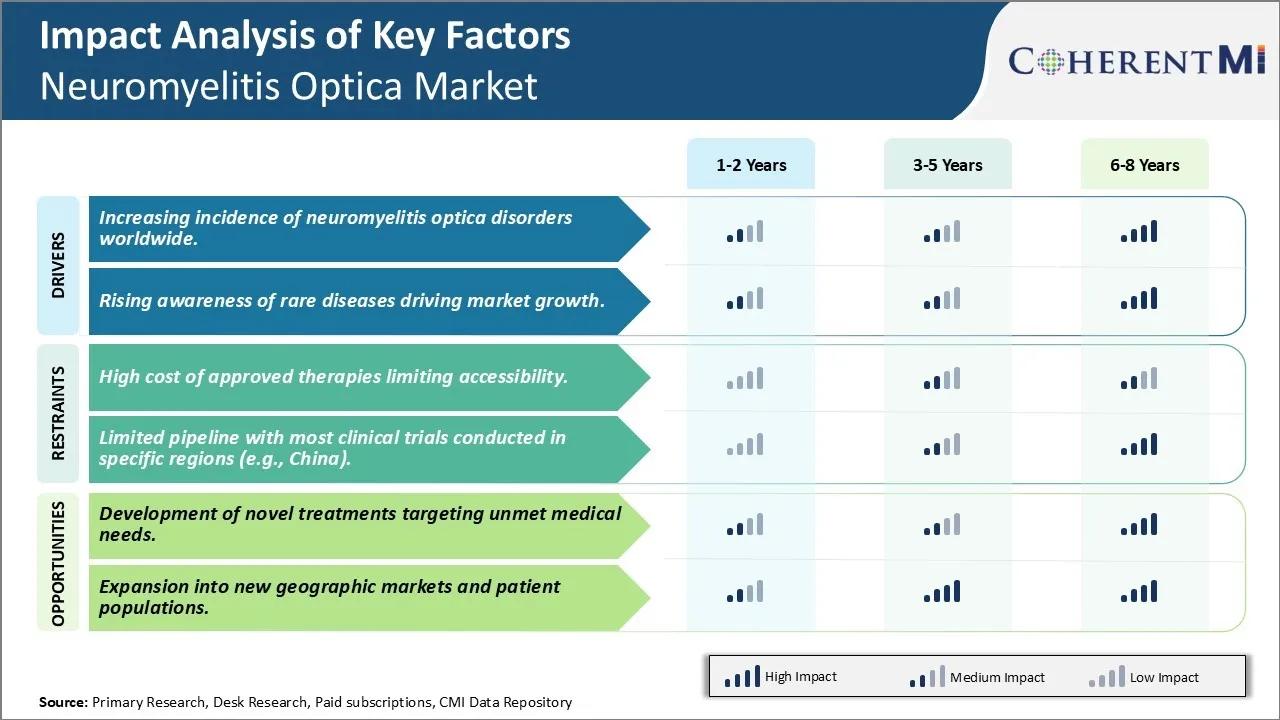Neuromyelitis Optica Market Trends
Market Driver - Increasing incidence of neuromyelitis optica disorders worldwide.
Increasing Incidence of Neuromyelitis Optica Disorders Worldwide
The global incidence of Neuromyelitis Optica (NMO) and NMO spectrum disorders has been consistently rising over the past few decades. While it was initially believed to be a rare disorder, more cases are being identified and reported worldwide. This increase can be attributed to several underlying factors.
Better awareness and diagnostic capabilities among neurologists and healthcare practitioners have led to improved disease detection and confirmation of diagnoses that may have previously been misclassified as Multiple Sclerosis. The development of sensitive detection tests for NMO-IgG antibodies has strengthened the ability to accurately differentiate NMO from MS, especially in patients exhibiting overlapping clinical symptoms. Additionally, growing knowledge of rare diseases in general has expanded the diagnostic perspectives to also consider NMO in differential diagnoses.
Genetic and environmental factors also play a key role in rising disease prevalence. Family history and genetic predisposition increase the risks for some individuals. Meanwhile, changes in lifestyle and living conditions have influenced ethnic variations and exposure rates to potential triggers across populations and regions. Growing urbanization with associated industrial and lifestyle changes could impact immune responses and contribute to the increased reporting globally. Improved availability of healthcare may also allow earlier diagnosis and reporting in developing areas.
The rise further stems from greater life expectancy rates due to advancements in medical care. An aging global demographic profile increases the at-risk population base over time. As people are living longer with better management of other chronic conditions, rare illnesses like NMO may emerge or progress at later stages of life.
Rising Awareness of Rare Diseases Driving Market Growth
In recent years, awareness about rare diseases has grown considerably among patient advocacy groups as well as the general public and policymakers. This is an encouraging trend that is positively impacting the Neuromyelitis Optica market landscape.
Heightened advocacy efforts by community organizations dedicated to rare diseases are helping draw attention, recognition and support for conditions like NMO. Launching of global awareness days and months as well as information campaigns on digital and social platforms have augmented understanding and responsiveness for patients' needs. Government agencies and legislators are accordingly aligning regulatory frameworks and reimbursement policies to better facilitate access to ongoing treatment and management.
Patients too are more proactively participating in online support groups and research registries to share lived experiences, gather relevant inputs and collaborate with scientific communities. This collective activism is expediting clinical progress as improving data and biomarkers help accelerate research. It also encourages pharmaceutical manufacturers and biotech startups to actively pursue development of novel treatment solutions for rare conditions previously neglected due to small affected populations.
As rare disease communities unite and voice grows louder, major healthcare stakeholders are responding suitably to new market needs and opportunities. Greater inclusion of unmet indications in clinical trial programs as well as expedited evaluation mechanisms for orphan drugs are getting set up. Majority of new product pipelines are also focusing on rare start indications. All these collaborative efforts are expected to boost overall NMO disease management and support the market's advancement in coming years.

Market Challenge - High cost of approved therapies limiting accessibility.
High Cost of Approved Therapies Limiting Accessibility
One of the major challenges faced by the neuromyelitis optica (NMO) market is the high cost of approved disease-modifying therapies limiting their accessibility to patients. The two FDA approved treatments for NMO, eculizumab (Soliris) and satralizumab (Enspryng), have list prices of over $500,000 per year. While both drugs have been shown to significantly reduce relapse rates in clinical trials, their immense costs make long-term treatment financially unviable for many patients. This is particularly problematic in countries with less robust public healthcare systems and limited reimbursement programs for orphan indications like NMO. The barriers to access created by high drug prices not only affect patients but can also negatively impact pharmaceutical companies' revenue potentials in these markets. Furthermore, high costs discourage physicians from prescribing approved treatments due to issues of affordability and sustainability for patients over the long run. This challenge poses serious limitations to penetration of novel therapies and overall market growth.
Development of Novel Treatments Targeting Unmet Medical Needs
There remains a significant opportunity for growth in the NMO market through the development of novel treatments that can target some of the unmet medical needs. While eculizumab and satralizumab have demonstrated high efficacy in reducing relapses, there is still room for developing more affordable therapies. Research into new mechanisms of action, such as B cell targeting antibodies and therapies preventing aquaporin-4 antibodies, hold promise for improved outcomes. Furthermore, developing oral or subcutaneous formulations can help address the need for more convenient administration options compared to the intravenous formulations of current drugs. Novel therapies achieving superior efficacy, more favorable dosing regimens, and especially lower costs than existing treatments have strong potential to gain higher market acceptance. This will not only expand patient access but also represent a valuable opportunity for companies to establish leadership in this growing specialty pharmaceutical space.